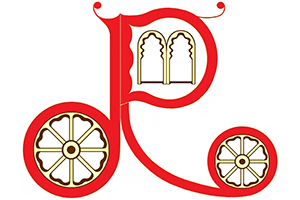MOST EXOTIC AND BEAUTIFUL ISLANDS IN THE SOUTH PACIFIC; FIJI ISLANDS
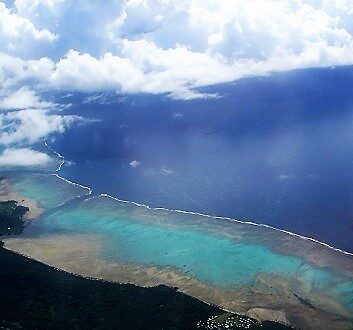
Fiji, Aerial View
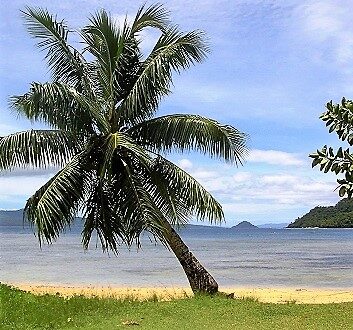
Fiji, Qamea Island
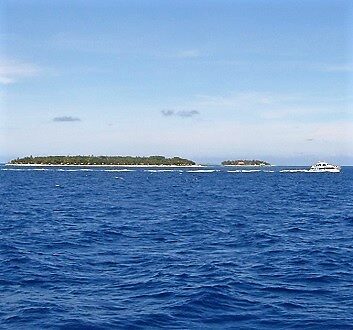
Fiji, Coastal Scenery Near Viti Levu Island
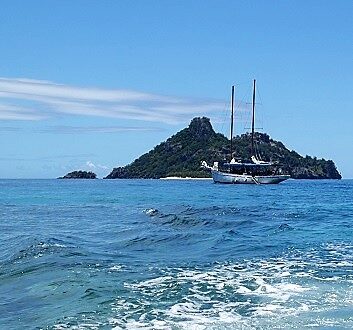
Fiji, Yasawa Islands
Travel Itinerary
Day 1 – Arrive Qamea Island, Fiji
There are direct flights from the west coast of USA, cities of Los Angeles and San Francisco to/from Nadi, Fiji. Upon arrival at the Nadi International Airport located on Viti Levu Island, we proceed to the domestic departures to take a 90 minutes’ flight to Taveuni Island’s Matei Airport. At the Matei Airport (also known as Taveuni Airport), we are greeted by the representatives of our resort. We enjoy a 20 minutes’ transfer through the forested Taveuni Island, followed by a 10 minutes’ boat transfer to the Qamea Resort and Spa. Our late afternoon arrival give us enough time to explore the pretty coves and white sand beaches on the island. We dine at our resort.
Note: Our Fiji Itinerary takes place in December-January. Fiji has a tropical climate, ensuring warm temperatures all year round. The dry weather runs from May to October while the rainy season runs from November to April. We recommend bringing a quality mosquito repellent. Fiji Islands receive a large number of visitors throughout the year, thanks to its wild beauty, exotic culture and the hospitality of the Fijian people.
Day 2 – Qamea Island (Beach Day, New Year’s Eve Celebrations)
We spend our day on the beach, organizing our days’ activities around the scheduled meals served in the resort. We snorkel, swim and sunbathe. The soft and hard corals are brilliant and colorful under the beaming sunshine. We explore the underwater coral gardens near our resort, encountering schools of tropical fish and a few turtles. In the evening, we celebrate New Year’s Eve with a festive dinner, Fijian Meke (traditional folk dances), a firework display and dancing on the beach.
Day 3 – Qamea Island (Scuba-Diving, Snorkeling, Ceremonies)
We schedule a private scuba dive with an experienced Divemaster. In the morning, we take a boat for 10 minutes near Taveuni Island to explore a spectacular coral reef. We observe a maze of yellow, violet and purple soft corals and magnificent sea fans. A relatively mild current pushes us along the vibrant marine life. After the dive, we have lunch and relax in our bure. We enjoy a sunny afternoon on the beach and snorkel over the beautiful coral reef near the shoreline. At sunset, we observe the Fijian rituals performed at the wedding ceremony of a couple staying in our resort. In the evening, we have a lively dinner with the other guests staying at the resort.
Day 4 – Qamea Island (Village Excursion, Jungle Hike, Beach)
A morning excursion to the nearby Fijian village shows the traditional way of life and culture of the Fijian people. We observe traditional Fijian dwellings, children playing in the nature and villagers preparing a Fijian feast in the underground oven (called lovo) for a wedding celebration. After having lunch at the resort, we hike in the tropical forest, then relax on the beach. We have a romantic dinner in our bure.
Day 5 – Qamea Island Departure; Arrive Viti Levu Island
We enjoy a morning snorkel, followed by breakfast. We depart Qamea Island midday to Matei Airport located on Taveuni Island, using the transfer services of the Qamea Resort and Spa. We take a 90 minutes’ flight to Nadi International Airport, located on Viti Levu Island. Upon our arrival in Nadi, we take an airport shuttle service, previously scheduled at the Sheraton Fiji Resort. At the resort, we spend time on the beach, then have dinner.
Day 6 – Luxury Cruise to Mamanuca Islands & Yasawa Islands
In the morning, we depart on a luxury cruise to Mamanuca Islands and Yasawa Islands, beautiful volcanic islands in western Fiji. We sail along uninhabited islands with rocky shorelines and forested islands with white sand beaches. Our cruise itinerary includes stops at a few islands, snorkeling, swimming, relaxation on the beach and lunch featuring local Fijian cuisine. A visit to the uninhabited island that was used as a backdrop for the “Blue Lagoon” movie, offers a magical snorkeling experience. We return to Viti Levu Island at the end of the day and admire a beautiful sunset. In the evening, we delight in a seafood dinner in our resort.
Day 7 – Viti Levu Island (Beach Half-Day, Nadi Tour)
After breakfast, we enjoy some watersports at our resort. Early afternoon, we visit the town of Nadi, located on the western side of Viti Levu Island. We degust Fijian cuisine, including our favorite dish, coconut and curry crab. Nadi hosts numerous cultural and religious sites, and a collection of quaint souvenir shops. We observe the daily city life of the Fijian people. We return to our resort for dinner.
Day 8 – Beach Day; Viti Levu Island, Fiji Departure
We reserve an additional half-day to stay in our resort and spend the entire day on the beach. In the evening, we transfer to Nadi International Airport and take our international flight home.
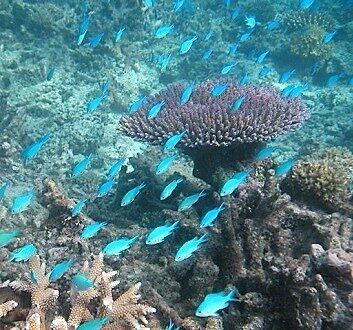
Fiji, Marine Life
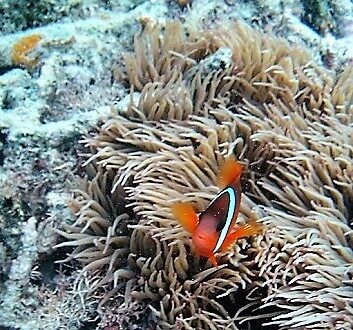
Fiji, Marine Life
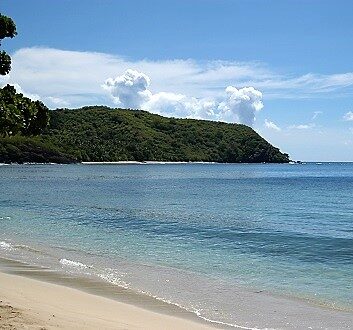
Fiji, Yasawa Islands
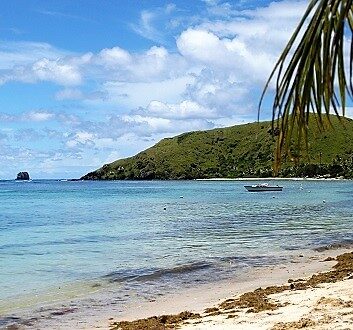
Fiji, Yasawa Islands
Special Places
Fiji – The Republic of Fiji, an archipelago in the South Pacific Ocean, consists of over 300 islands and over 500 of islets. Over 100 islands are inhabited, including the two main islands: Viti Levu Island and Vanua Levu Island. Viti Levu, the largest island of Fiji, hosts its capital city of Suva on the island’s southeastern coast. Nadi, a town in the west of the island, is the location of the primary gateway to Fiji, Nadi International Airport. The Fiji Islands are volcanic in origin and surrounded by brilliant coral reefs. Coastlines of the islands showcase towering cliffs along turquoise-blue ocean waters and white sand beaches lined with coconut trees. Fiji’s topography comprises volcanic mountains, tropical rainforests, grasslands and agricultural land used to cultivate cocoa, bananas, cassava, kava and taro (called dalo in Fijian). Over the centuries, Fiji was influenced by the cultural diversity of European, Indian and Chinese communities. Fiji’s indigenous culture is unique, colorful and thriving. Visitors to Fiji can discover ancient rituals, unique clothing, basket weaving traditions, cultural dances, melodious songs and indigenous Fijian ceremonies, including the Kava Ceremony. In towns and remote villages, Fijians practice “Fiji Time”, a laid-back and carefree approach to life, where scheduled events are never on time. Across the islands, a collection of luxury resorts attract visitors with panoramic ocean views, pristine beaches and stunning underwater ecosystems. Fiji has an extraordinary and vibrant marine life, including colorful sponges and spectacular sea fans, schools of tropical fish, majestic manta rays and diverse species of sharks and turtles. Mangrove trees, coconut trees and ironwoods grow along the beaches and the coastlines. Fiji has a tropical climate, ensuring warm temperatures all year round. Dry season runs from May to October while rainy season runs from November to April. The south-eastern parts of Fiji experience a higher rainfall while the western coastlines have a sunnier weather.
Qamea Island – The Vanua Levu Group, a group of islands in northern Fiji, is blessed with awe-inspiring coral reefs, a vibrant marine life and amazing beaches. The northern coastline of Vanua Levu Island is protected by the Cakaulevu Reef (Great Sea Reef), the world’s third longest barrier reef. Taveuni Island, situated east of Vanua Levu, is the third-largest island in Fiji. The Bouma National Heritage Park occupies about 80% of the island, enchanting nature lovers with a lush tropical vegetation, a flourishing rainforest, rare bird species and unique plants. There are direct flights from Nadi International Airport, located on the Viti Levu Island, to Matei Airport, located on Taveuni Island. The 90 minutes’ flight overlooks the Pacific Ocean, vibrant coral reefs and remote islands. Upon arrival at the Matei Airport (also known as Taveuni Airport), we are greeted by the representatives of our resort. We enjoy a 20 minutes’ transfer through the forested Taveuni Island, followed by a 10 minutes’ boat transfer to the Qamea Resort and Spa. The Qamea Resort and Spa, located on the picturesque Qamea Island, is a premium destination for scuba diving enthusiasts, a couples-only vacation escape, honeymoon vacations and a highly-desired location for romantic beach weddings. During our stay, we observe a few wedding ceremonies that incorporate and celebrate the traditional rituals of the indigenous Fijian people. As the sunset approaches, the Fijian warriors, the priest and the musicians lead the wedding procession to the beach. The wedding rituals include rhythmic Fijian songs and the traditional kava ceremony. Qamea Island is a remote and wild island with pretty coves, lovely beaches and a rainforest with diverse flora and fauna, including the endemic orange dove. The island is a natural paradise with scenic hikes, turquoise ocean waters and spectacular coral reefs. During the months of November and December, Qamea Island experiences a large migration of red land crabs, called lairo, traversing the island toward the sea in order to breed. An excursion to the nearby Fijian village educates us about the traditional way of life and the unique culture of the Fijian people. We observe children playing in nature and the village community preparing the traditional underground oven (called lovo) for the wedding celebration. Surrounded by the striking beauty of nature, the Fijian people are warm, joyful and welcoming. Qamea Island is a heavenly escape, boasting wild beauty and an extraordinary marine biodiversity.
Viti Levu Island – The Viti Levu is the largest island in the Fijian archipelago. The topography of Viti Levu Island includes dormant volcanos, lush tropical rainforest, beautiful waterfalls, fertile farmlands and white sand beaches. The central part of Viti Levu Island is covered with lush forests and encompasses Mount Tomanivi, the highest mountain peak in Fiji. The capital city of Suva, located on the island’s southeastern coast, serves as the political, commercial and cultural center of Fiji. The town of Nadi, located on the western side of the Viti Levu, is also the location of Nadi International Airport, the primary gateway to Fiji. Nadi hosts numerous cultural and religious sites, and a collection of quaint souvenir shops. Visitors to Nadi can observe the daily city life of the Fijian people and degust local Fijian cuisine. Located within a 25 minutes’ drive from Nadi International Airport, Denarau Island is a private island that encompasses luxury resorts, the Denarau Golf Club and the Port Denarau Marina. The Sheraton Fiji Resort, located on the sunny western coast, is a family-friendly luxury escape with access to the Denarau Golf & Racquet Club. The Port Denarau Marina is a gateway for sport fishing expeditions, scuba-diving excursions, luxury cruises and sea transfers to the Mamanuca Islands and the Yasawa Islands. The western coast of Viti Levu Island enchants its visitors with pristine beaches, turquoise ocean waters, sun-filled adventures and intriguing culture.
Yasawa Islands – The Yasawa Islands Group, located in western Fiji, consists of small islands and the six larger islands of Yasawa, Waya, Nacula, Naviti, Yaqeta and Matacawalevu. The Yasawa Islands are a stretch of beautiful volcanic islands with dramatic peaks rising from the Pacific Ocean. A luxury day cruise to the Mamanuca Islands and the Yasawa Islands reveals shimmering ocean waters, palm-fringed islands and magnificent shorelines with sun-drenched white sand beaches. We enjoy plentiful sunshine, warm air and calm ocean waters as we sail toward the remote cluster of islands. We admire uninhabited islands with rocky shorelines and forested islands with sandy beaches. Our cruise itinerary includes stops at a few islands, snorkeling, swimming, relaxation on the beach and lunch featuring local Fijian cuisine. We visit an uninhabited island that was used as a backdrop for the “Blue Lagoon” movie. The idyllic coves, gorgeous white sand beaches and crystal-clear waters offer serenity and a feeling of seclusion. The coral reefs create a rich habitat for diverse schools of fish that swim surprisingly near our faces. These lovely encounters symbolize the remoteness, wilderness and alluring beauty of western Fiji. We return to Viti Levu Island at the end of the day and admire a beautiful sunset.
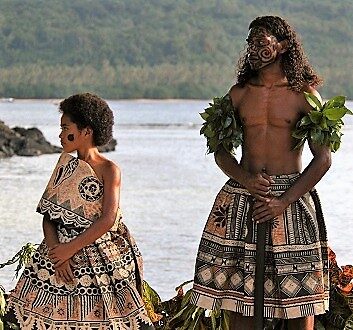
Fiji, Qamea Island, Qamea Resort and Spa, Wedding Ceremony
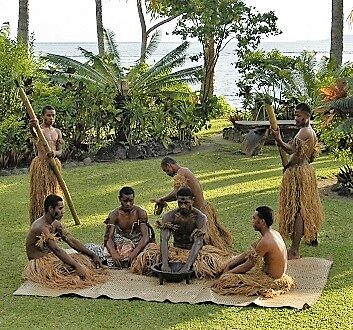
Fiji, Qamea Island, Qamea Resort and Spa, Kava Ceremony
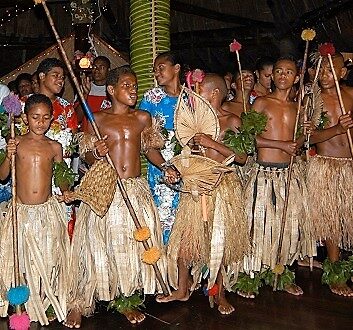
Fiji, Qamea Island, Qamea Resort and Spa, Fijian Meke
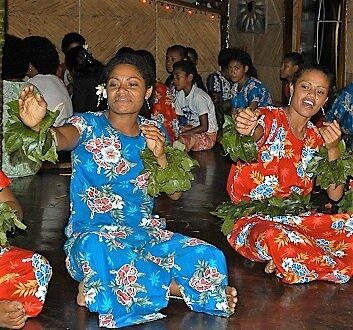
Fiji, Qamea Island, Qamea Resort and Spa, Fijian Meke
Favorite Adventures
Fijian Culture – Fiji is a natural paradise with sandy beaches, turquoise ocean waters and tropical climate that inspire creativity. Fijian people preserve their cultural heritage by incorporating art and music in their daily lives. Travelers visiting Fiji are welcomed with Fijian folk songs, expressive dances and flower garlands, called salusalu. Mat and basket weaving, wood carving and making masi are old art forms practiced in Fiji. Masi is a tapa cloth made from the bark of the paper mulberry tree that is soaked in water and treated with tapa beaters. Masi (tapa cloth) is decorated with intricate motifs and traditional patterns, then used to make ceremonial dresses, wall décor and other folkloric artwork. Fijians’ warmth, hospitality and relaxed way of life is reflected in their exotic customs and traditions. Fiji’s pristine beaches are the perfect backdrop for a romantic Wedding Ceremony. Couples wanting to exchange their vows experience the traditional rituals of the indigenous Fijian people. As the sunset approaches, the Fijian “warriors” dressed in traditional clothing, the priest and the Fijian choir guide the wedding procession to the beach. The wedding rituals include soulful Fijian music and the traditional Kava Ceremony. Kava, also called yagona, is the sun-dried crushed root of the yagona plant mixed with water. Kava, the non-alcoholic national drink of Fiji, creates a slightly numbing and calming effect. The Kava Ceremony is a traditional ritual to celebrate weddings, official visits and other significant festivities. The families, friends and visitors gather on the floor in a circle and drink kava from coconut shells. Fijian people practice this ritual in their daily lives. The highlight of our journey is the Fijian Meke performed by the village men, women and children during the New Year’s Eve Celebration. A festive dinner at the Qamea Resort and Spa includes a feast of lairo crab, refreshing salads and delicious desserts. The Fijian Meke is a traditional folk dance and a form of storytelling through songs. Rhythmic songs and spirited dances tell folktales, legends and stories of the village life. The Fijian spear dance involves men in warrior costumes, simulating the usage of long sticks with spears. Fijian women dressed in the traditional Sulu (Fijian sarong) and flower garlands (Salusalu) perform the fan dance and the seated dance. The sequence of dance moves and hand gestures are part of rituals practiced by Fijian people. The New Year’s Eve countdown takes place on the beach, dancing around the bonfire and a firework display illuminating the star-studded skyline.
Scuba Diving – The exotic islands of Fiji are a world’s top destination for snorkeling and scuba diving enthusiasts. The coastlines of the Qamea Island and Taveuni Island have excellent dive sites located within a 10 minutes’ boat ride from the Qamea Resort and Spa. The coastal ecosystems include a maze of coral reefs with colorful sea fans, different species of fish, turtles, mantas and reef sharks. The resort also organizes charter dives to the world’s premiere dive sites for experienced divers. The famous Rainbow Reef is located in the Somosomo Strait, a narrow stretch of water between Taveuni Island and Vanua Levu Island. The coral garden with large orange, pink, red, yellow, blue and purple soft coral bushes creates an enchanting underwater paradise. The Great White Wall is a spectacular vertical wall covered with brilliant soft white coral and frequented by colorful schools of fish.
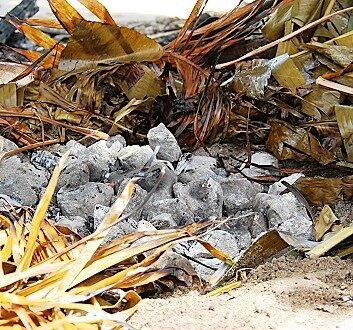
Fiji, Qamea Island, Lovo (Underground Oven)
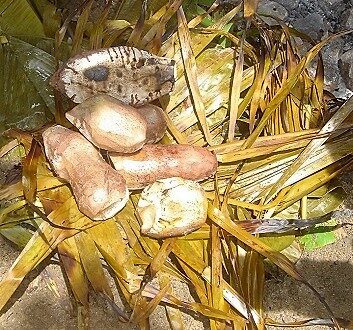
Fiji, Qamea Island, Roasted Taro
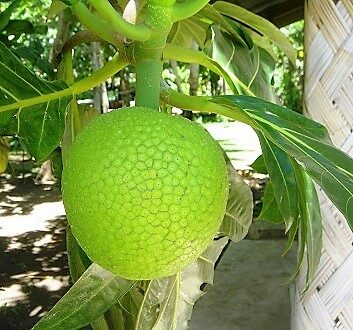
Fiji, Qamea Island, Breadfruit
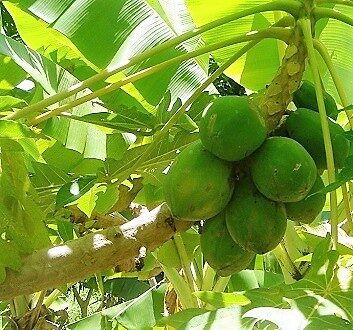
Fiji, Qamea Island, Papaya
Selected Cuisine
Fijian Cuisine – Fiji’s fertile underwater ecosystems and farmlands ensure a consistent supply of fresh seafood, taro root, cassava root vegetable, breadfruit, rice, coconut and other tropical fruits. Fijian cuisine utilizes diverse ingredients and traditional cooking techniques. Indian and Chinese migrant communities introduced their own cooking methods, fragrant curries and spices, thus influencing the Fijian cuisine.
Lovo – The traditional Fijian feast prepared for special celebrations, is traditionally cooked in the underground oven called lovo. Fijian villagers use the earth oven to slowly cook diverse foods. A hole in the ground is lined with leaves of the taro plant and the banana plant. Diverse meats, fish and vegetables are wrapped in banana and taro leaves, then placed in the hole together with heated stones. The food is covered with banana leaves and left to cook slowly for a few hours. This slow cooking technique in the earth oven delivers tender-textured and flavorful food.
Taro Root – Taro, a tropical plant native to Southeast Asia, is widely cultivated in Fiji. The taro plant has heart-shaped leaves and the taro root is called corm. The taro root is usually boiled or baked, then fried to make taro chips. Taro is a starchy vegetable, highly nutritious with a texture similar to a potato. While visiting a Fijian village, we observe taro (called dalo in Fijian) baked in an earth oven for the wedding festivities.
Breadfruit – Breadfruit, a tropical fruit native to New Guinea, is cultivated in many islands in the South Pacific. The breadfruit tree produces a starchy large breadfruit that has a potato-like flavor. Breadfruit can be roasted whole in a fire, baked, boiled or fried to make delicious breadfruit chips. A dried breadfruit is ground into flour and used for baking.
Papaya – Papaya is a large tree-like plant, native to Central America. It is widely cultivated in tropical and subtropical climates. The Fijian red papaya, called pawpaw, is juicy and sweet, and has an orange-red flesh. Ripened papaya has a greenish-yellow skin and is eaten raw. The green papaya is picked unripe and eaten raw in salads. It is tangy, crunchy and delectable.
Lairo Crab – Lairo crab is a red land crab that lives in the hilly mountains. During the months of November and December, the shorelines of Qamea Island experience a large migration of lairo crabs, traversing the island toward the sea in order to breed. Our Qamea Resort and Spa serves a superb New Year’s feast, featuring Lairo Crab prepared with coconut, chili sauce and spices. It is a sumptuous dish that perfectly unifies the delicate crab texture with the thick spicy sauce.
Coconut Rice – A traditional Fijian breakfast often includes coconut rice. The Fijian rice is slowly cooked in coconut milk and lightly sweetened. The coconut rice is fragrant, creamy and very flavorful. It is simply delicious.
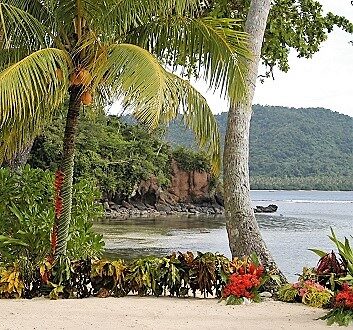
Fiji, Qamea Island, Qamea Resort and Spa
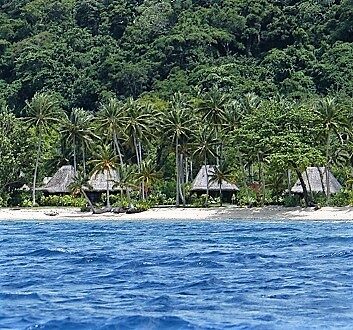
Fiji, Qamea Island, Qamea Resort and Spa
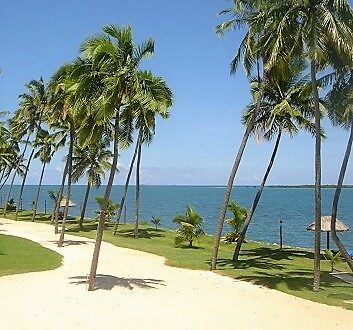
Fiji, Viti Levu Island, Sheraton Fiji Resort
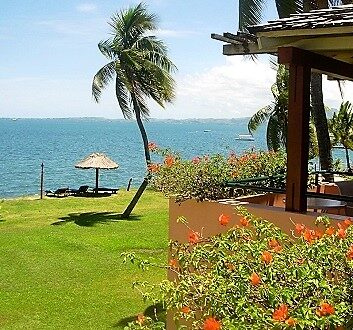
Fiji, Viti Levu Island, Sheraton Fiji Resort
Preferred Accommodations
Qamea Resort and Spa – Qamea Island is a beautiful island in the northern Fiji, blessed with sandy beaches, spectacular coral reefs, verdant hills and a tropical jungle. The Qamea Resort and Spa, located on Qamea Island, is a luxury boutique resort set on a private white sand beach. The couples-only resort has 15 Luxury Fiji Villas (bures) with thatched roofs, nestled along the beach and the tropical gardens. An all-inclusive resort serves a fusion of Fijian Pacific Rim cuisine, featuring local seafood and produce, and imported ingredients. Guests can enjoy private dining or unique communal dining, meeting other guests from around the world. The Qamea Resort and Spa organizes various activities, including charter dives, snorkeling excursions, nature hikes, sport fishing and village tours. Guests of the resort experience the authentic Fijian culture on a daily basis, expressed through music, traditional ceremonies and the incredibly hospitable Fijian people.
Sheraton Fiji Resort – Denarau Island is a private island located on the sunny western coast of Viti Levu, Fiji’s largest island. Denarau Island hosts the Port Denarau Marina, a golf club, boutiques, restaurants and luxury resorts, including the Sheraton Fiji Resort. This family-friendly resort is set along a white sand beach and has a collection of rooms with a private balcony or patio, overlooking the ocean or the gardens. Guests of the resort enjoy a lagoon style swimming pool, privileges at the Denarau Golf & Racquet Club and watersports activities. The Sheraton Fiji Resort is an ultimate tropical escape with great dining, excellent guest services and a distinctive Fijian culture. Note: The Sheraton Fiji Resort is completing renovations and will reopen in April 2021.
